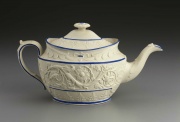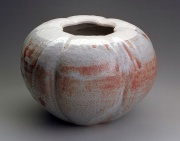Difference between revisions of "Stoneware"
Jump to navigation
Jump to search
(username removed) |
|||
| (2 intermediate revisions by one other user not shown) | |||
| Line 1: | Line 1: | ||
| − | [[File:00.378a-b-SC8861.jpg|thumb|]] | + | [[File:00.378a-b-SC8861.jpg|thumb|Teapot<br>MFA# 00.378]] |
== Description == | == Description == | ||
| − | A hard, opaque, nonporous [ | + | A hard, opaque, nonporous [[ceramic|ceramic]]. Stoneware is made from [[secondary%20clay|secondary clay]] and fired at temperatures of 1200-1300 C. It was made in China as early as 1400 BCE. The presence or absence of trace components in the clay can color stoneware white, gray, black, red, or brown. Stoneware can be unglazed or glazed with [[lead%20glaze|lead]] or [[salt%20glaze|salt]] glazes. |
| − | [[File:1998.439-SC8285.jpg|thumb|]] | + | [[File:1998.439-SC8285.jpg|thumb|Lobed Vase<br>MFA # 1998.439]] |
== Synonyms and Related Terms == | == Synonyms and Related Terms == | ||
faïence (Fr.); grés (Port.) | faïence (Fr.); grés (Port.) | ||
| − | == | + | == Resources and Citations == |
* Random House, ''Webster's Encyclopedic Unabridged Dictionary of the English Language'', Grammercy Book, New York, 1997 | * Random House, ''Webster's Encyclopedic Unabridged Dictionary of the English Language'', Grammercy Book, New York, 1997 | ||
Latest revision as of 12:17, 4 August 2020
Description
A hard, opaque, nonporous Ceramic. Stoneware is made from Secondary clay and fired at temperatures of 1200-1300 C. It was made in China as early as 1400 BCE. The presence or absence of trace components in the clay can color stoneware white, gray, black, red, or brown. Stoneware can be unglazed or glazed with lead or salt glazes.
Synonyms and Related Terms
faïence (Fr.); grés (Port.)
Resources and Citations
- Random House, Webster's Encyclopedic Unabridged Dictionary of the English Language, Grammercy Book, New York, 1997
- The American Heritage Dictionary or Encarta, via Microsoft Bookshelf 98, Microsoft Corp., 1998
- The Dictionary of Art, Grove's Dictionaries Inc., New York, 1996 Comment: "Ceramics"

